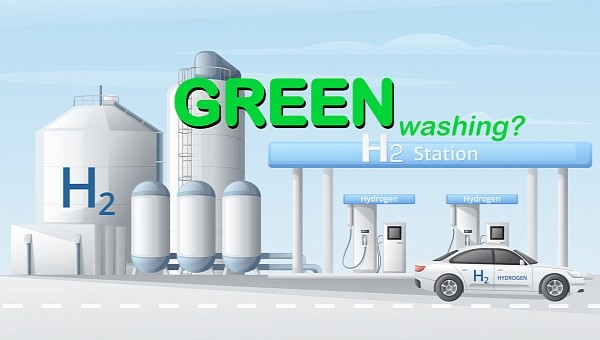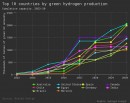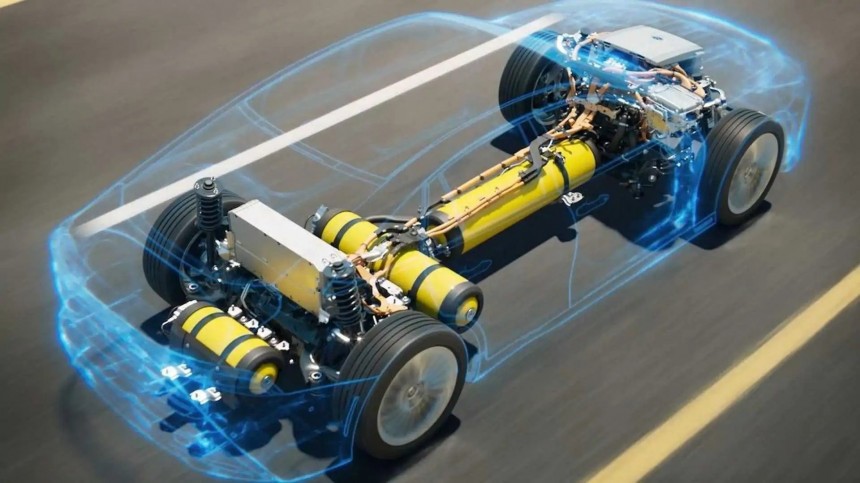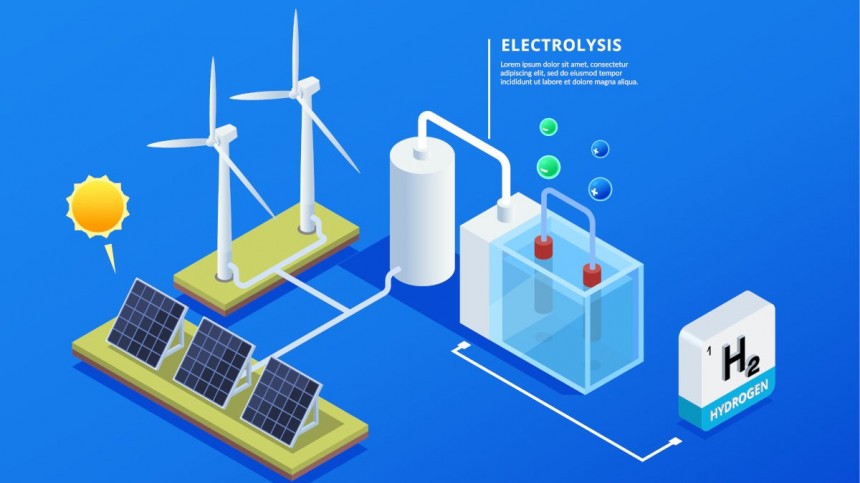As you know, hydrogen is touted by Big Oil as the zero-emissions technology we should bet on in the long run. Now, China brags it’s taking the lead in terms of behemoth renewable H2 projects. However, projections show that China won’t join the green hydrogen top players, at least not until 2030. Besides, the new green H2 facility is raising big questions about the ‘green’ label.
Sinopec is a Chinese state-owned company and second-largest oil refining, gas, and petrochemical company in the world after Saudi Aramco. So, it’s no wonder it has the big money needed to invest in large renewable projects. Yes, you heard me, the oil company Sinopec is into renewables.
Their recent investment is touted as “the world's largest green hydrogen-coal chemical project.” Let’s shed some light on this curious juxtaposition of the terms ‘green hydrogen’ and ‘coal chemical,’ because there are concerns that this project won’t be as ‘clean’ as it’s promoted by authorities.
To put things into perspective, let’s take the example of the Toyota Mirai, the most popular fuel-cell car. It has a range of 404 miles (650 km) using 12.3 lbs. (5.6 kg) of hydrogen. On average, an American drives less than 15,000 miles (24,000 km) per year, so a Mirai would need around 450 lbs. of H2 per year.
So, in theory, the 20,000 tons of green hydrogen from the Kuqa plant could supply almost 100,000 Mirais per year. This looks like a win-win scenario because the Chinese government aims to put on the road at least 50,000 fuel-cell vehicles by 2025. But…
There’s always that annoying ‘but.’ Although Sinopec is already developing an H2 refueling station network in China for fuel cell vehicles, the Kuqa plant’s purpose is different. Its green hydrogen will be used to remove sulfur from crude oil at the Kuqa oil refinery. There’s no mistake: green hydrogen will be used for an oil refinery.
The paradox is the 260 MW electrolyzer requires more than 1 TWh of power per year. Originally, this huge quantity of electricity was planned to be sourced from a massive solar farm. But in the meantime, the solar farm was reduced to a third of its designed capacity, and the rest of the energy will be provided by ‘good old’ coal power plants.
According to BloombergNEF, if half of the energy required by the electrolyzer comes from coal-powered plants, the carbon intensity of the Kuqa plant’s so-called green hydrogen will be greater than the current gray hydrogen, sourced from the reforming of natural gas.
To make things worse, it seems that Xinjiang province is appropriate for wind power. Still, the local grid is mostly based on coal-fired power, while Sinopec’s plans don’t include any wind projects in the area. In the end, the ‘green hydrogen’ of Kuqa is raising big questions.
It will use electricity both from wind farms and solar farms. The wind farm’s power-generating capacity is estimated at 270 MW, while the solar farm will reach 450 MW. That’s a total of a little more than 720 MW, which is only three-quarters of the Kuqa’s power demand.
Why is this important? Because Erdo’s facility is meant to achieve a capacity of 30,000 tons of hydrogen production by water electrolysis per year. This is 30% more than Kuqa’s facility, but Sinopec states it needs 25% less electricity. Something doesn’t add up unless the technology for Erdo’s project is a real breakthrough compared to Kuqa’s project. And it's not.
But as you already guessed, the details for this new “world’s biggest” project is too scarce to possibly solve all the puzzles it sparks. At this point, it’s more of a marketing gimmick, meant to emphasize the Beijing government declared plans for 200,000 tons of H2 annually from 2025 onward.
It seems that, based on real data and projects in the pipeline, the leaders in green hydrogen production will be Australia, the United States, and Spain. The other countries are Canada, Chile, Egypt, Germany, India, Brazil, and Morocco.
For instance, last year, the Spanish government approved the Puertollano project. It is expected to produce 200,000 tons of green hydrogen per year, which is ten times more than China’s Kuqa facility. Australia and the U.S. are expected to pass the 2 million tons cumulative capacity by 2030.
Projections show that these ten countries could cumulatively produce more than 15 million tons of green hydrogen by 2030. In the same year, the global fleet of fuel cell vehicles is expected to pass the 10 million mark, according to Hydrogen Council.
Of course, hydrogen is not meant only for the transportation sector. Nevertheless, this sector is expected to be its major ‘client.’ Just as, today, more than half of the oil in the world is consumed by internal combustion engines in vehicles.
We’ll have to wait and see if the “world’s largest” touted project by the Chinese company really is such a thing. At least Europe’s regulations for ‘green H2’ stipulates that it’s only green while the electricity needed is 100% renewable. Otherwise, ‘green’ is for something else.
Their recent investment is touted as “the world's largest green hydrogen-coal chemical project.” Let’s shed some light on this curious juxtaposition of the terms ‘green hydrogen’ and ‘coal chemical,’ because there are concerns that this project won’t be as ‘clean’ as it’s promoted by authorities.
Green hydrogen sounds great. But is it really green?
Firstly, you should know that China is racing itself. The biggest green hydrogen project construction was started in 2021 in Kuqa, Xinjiang province, and it should become operational in the summer of 2023. It’s planned to produce 20,000 tons of green hydrogen per year.To put things into perspective, let’s take the example of the Toyota Mirai, the most popular fuel-cell car. It has a range of 404 miles (650 km) using 12.3 lbs. (5.6 kg) of hydrogen. On average, an American drives less than 15,000 miles (24,000 km) per year, so a Mirai would need around 450 lbs. of H2 per year.
So, in theory, the 20,000 tons of green hydrogen from the Kuqa plant could supply almost 100,000 Mirais per year. This looks like a win-win scenario because the Chinese government aims to put on the road at least 50,000 fuel-cell vehicles by 2025. But…
The paradox is the 260 MW electrolyzer requires more than 1 TWh of power per year. Originally, this huge quantity of electricity was planned to be sourced from a massive solar farm. But in the meantime, the solar farm was reduced to a third of its designed capacity, and the rest of the energy will be provided by ‘good old’ coal power plants.
According to BloombergNEF, if half of the energy required by the electrolyzer comes from coal-powered plants, the carbon intensity of the Kuqa plant’s so-called green hydrogen will be greater than the current gray hydrogen, sourced from the reforming of natural gas.
To make things worse, it seems that Xinjiang province is appropriate for wind power. Still, the local grid is mostly based on coal-fired power, while Sinopec’s plans don’t include any wind projects in the area. In the end, the ‘green hydrogen’ of Kuqa is raising big questions.
Solar and wind for hydrogen to be used in… fossil fuels processing?!
Now we’re getting back to the main subject: the new project is called “the Inner Mongolia Erdos Wind-Solar Green Hydrogen Project.” And get this, it is actually a ‘demonstration project.’ More, it is said it will source green hydrogen for “the carbon reduction initiatives” of an intensive coal processing pilot project in the same area.It will use electricity both from wind farms and solar farms. The wind farm’s power-generating capacity is estimated at 270 MW, while the solar farm will reach 450 MW. That’s a total of a little more than 720 MW, which is only three-quarters of the Kuqa’s power demand.
Why is this important? Because Erdo’s facility is meant to achieve a capacity of 30,000 tons of hydrogen production by water electrolysis per year. This is 30% more than Kuqa’s facility, but Sinopec states it needs 25% less electricity. Something doesn’t add up unless the technology for Erdo’s project is a real breakthrough compared to Kuqa’s project. And it's not.
But as you already guessed, the details for this new “world’s biggest” project is too scarce to possibly solve all the puzzles it sparks. At this point, it’s more of a marketing gimmick, meant to emphasize the Beijing government declared plans for 200,000 tons of H2 annually from 2025 onward.
China aims high with H2, but it won’t make it to the H2 top
The business intelligence Rystad Energy forecasts that, despite its ambitious plans, China won’t be in the top ten in 2030. That is the TOP 10 countries that will be the biggest producers of green hydrogen in 2030.It seems that, based on real data and projects in the pipeline, the leaders in green hydrogen production will be Australia, the United States, and Spain. The other countries are Canada, Chile, Egypt, Germany, India, Brazil, and Morocco.
For instance, last year, the Spanish government approved the Puertollano project. It is expected to produce 200,000 tons of green hydrogen per year, which is ten times more than China’s Kuqa facility. Australia and the U.S. are expected to pass the 2 million tons cumulative capacity by 2030.
Of course, hydrogen is not meant only for the transportation sector. Nevertheless, this sector is expected to be its major ‘client.’ Just as, today, more than half of the oil in the world is consumed by internal combustion engines in vehicles.
We’ll have to wait and see if the “world’s largest” touted project by the Chinese company really is such a thing. At least Europe’s regulations for ‘green H2’ stipulates that it’s only green while the electricity needed is 100% renewable. Otherwise, ‘green’ is for something else.








